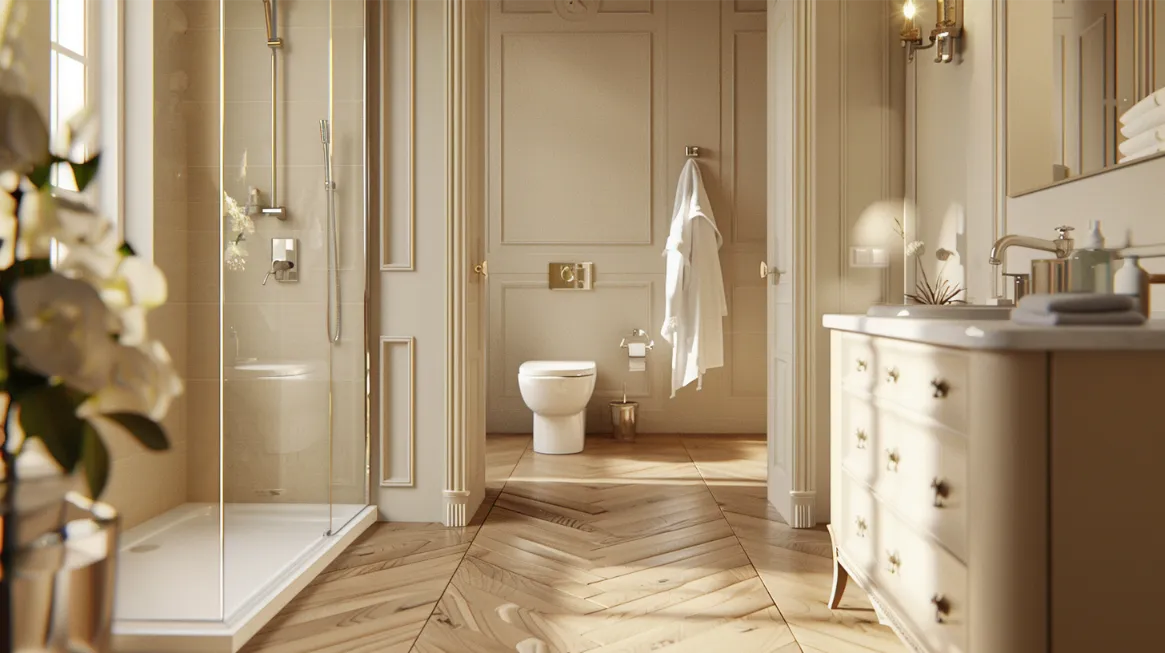To craft a picture frame as a beginner, gather essential tools: a miter saw, router, glass cutter, clamps, and sanding tools. Measure artwork size, add 2-4 inches for mat borders, and select a standard frame size. Mill lumber by ripping wood for width, cross-cutting for sides, and making 45° cuts with rabbets. Strengthen joints with splines or dowels using a miter saw for precision. Assemble frames with wood glue and clamps and reinforce corners. Mount artwork with mat board, secure it with glazing and hang it using D-ring hangers or wire. Customize with exotic woods or mixed materials for unique designs. Explore advanced techniques for creative flair.
Key Takeaways
- Measure artwork and add border size.
- Mill lumber for frame components.
- Use accurate 45° miter cuts for joints.
- Apply wood glue generously for assembly.
- Securely hang the frame with the appropriate hardware.
Tools and Materials Required
To construct a basic picture frame, you will need:
Tools:
- A miter saw, miter box, and backsaw are used to cut precise angled frame joints.
- Router and straight bit for cutting rabbets
- Mat cutter for beveled openings in the mat board
- Glass/acrylic cutter
- Clamps for securing joints during assembly
- Sanding tools
- Hammer, nail setter, glazing points for securing inner components
When making a picture frame, gather essential tools like a miter saw, router, glass/acrylic cutter, clamps, and sanding tools for a successful construction process. The miter saw is vital for cutting precise angled frame joints, while the router with a straight bit is used for cutting rabbets to hold inner components. A glass/acrylic cutter must cut the glazing material to the correct size. Additionally, clamps are essential for securing joints during assembly, ensuring a sturdy frame.
Materials:
- Wood, metal, or plastic for the frame itself
- Mat board
- Glass or acrylic glazing sheet
- Backing board like acid-free foam core
- Wood glue
- Glazing points/tape/sealing compound
- Hanging hardware like D-rings and wire
For materials, you’ll need wood for the frame itself, mat board, glass or acrylic glazing sheet, and a backing board like acid-free foam core. Wood glue is essential for securely joining frame pieces, while glazing points or tape secures the inner components. Finally, hanging hardware like D-rings and wire should be included for easy display once the frame is completed. With these tools and materials, you can construct your picture frame efficiently and effectively.
Determining Frame Dimensions
Consider the artwork’s size and required mat borders to determine your frame’s dimensions accurately. Start by measuring the width and height of your artwork, such as an 8′ x 10′ piece. Add 2-4 inches to each dimension to accommodate the mat borders, making the desired mat opening 12′ x 14′. Choose a standard frame size 16’x20′ that can fit this mat opening, providing an approximate 4′ mat border around your artwork.
Remember that mat boards are cut slightly smaller than the artwork size to create an overlapping border when accounting for mat board and glazing. For an 8’x10′ artwork, the mat opening might be cut to 7.5’x9.5′. Make sure the glazing fits precisely within the frame’s rabbet depth.
Consider customization options like varying frame widths, offset mats, multiple mats, or adding a fillet to enhance the design while maintaining functionality. Customize the frame to suit your aesthetic preferences while ensuring it complements the artwork perfectly.
Milling Lumber for the Frame
Considering the wood species selected for your picture frame, the next step involves milling the lumber to the appropriate dimensions for the frame components. Start by ripping the wood on a table saw to achieve the desired frame width, typically 1′ to 3′. Then, cross-cut the boards to the length needed for the four frame sides, making sure to factor in a 45° miter cut at each end. Use a miter saw or miter box to accurately cut the 45° miters on the frame pieces. Remember to sand the freshly cut ends for tight miter joints during assembly. It’s essential to have all four frame pieces cut to the same length for seamless, square corners when joined together. Utilizing stop blocks on the miter saw can help maintain consistent length.
Next, rabbets should be created along the inner edge of the assembled frame to accommodate the glazing, mat(s), artwork, and backing board. Set the depth of a straight or rabbet router bit to the desired depth, typically between 1/4′ and 1/2′. Adjust the router fence or edge guide to the desired rabbet width, typically between 1/4′ and 3/8′. Rout along the inner edge of each frame piece to remove material and form the rabbet groove. Ensure the rabbet depth and width are sufficient to fit all inner components snugly while allowing room for expansion and contraction. Some frames may feature additional design elements like a small lip or detailing along the inner edge of the rabbet for added visual appeal. By carefully milling the wood and creating precise rabbets, you’ll have all the necessary frame components ready for assembling a professional, archival-quality picture frame.
Joinery Techniques for Picture Frames
Employ precise cutting techniques to guarantee tight-fitting joints when constructing picture frames. When focusing on joinery techniques, consider the following:
- Miter Cuts: Assure accurate 45-degree cuts on frame corners for seamless joints.
- Spline Reinforcement: Strengthen joints by adding splines – precise grooves across the miter filled with matching keys.
- Dowel Reinforcement: Enhance joint durability by inserting dowels across mitered corners at an angle.
- Frame Corners: Pay close attention to the corners of the frame to achieve a polished and secure finish.
When making miter cuts, use a miter saw or miter box with a backsaw for precision. Consider spline and dowel reinforcements for added strength, especially for larger frames where extra support is necessary.
Frame Assembly and Finishing
When putting together and completing your picture frame, ensure tight-mitered corners by applying wood glue generously and using proper clamping techniques for a seamless final assembly. Lay out the frame pieces in their final configuration and confirm the corners fit snugly. Use thick wood glue on the miter surfaces, and if using splines or dowels, glue should be applied to the grooves or holes.
Assemble one corner at a time, confirming tight joints and reinforcing with splines or dowels. Secure all four corners with strap clamps, aligning them correctly, and check for squareness by measuring diagonals. Allow the glue to cure for 24 hours before removing the clamps. Trim any excess glue or material using a chisel or razor blade, confirming clean and flush joints to fit inner components properly. After trimming, sand the frame surfaces lightly for a smooth finish.
Apply stains, paints, or clear finishes when the frame is smooth. Follow the appropriate steps for each finish type, confirming even application and proper drying times between coats for a durable and attractive final look.
Mounting Artwork and Glazing
Cut the mat board and glazing material with precise measurements and clean cuts to mount artwork and glazing in your picture frame.
Cutting Mat Board:
- Measure the frame’s rabbet’s inside opening to determine the needed mat size.
- Use a mat cutter or straightedge with a utility knife to cut the window opening in your mat board, leaving about a 1/8′ border around the artwork.
- Cut the openings progressively smaller in each layer for double or triple mats.
- Consider using a beveled mat cutter to add an angle cut on the window opening.
Cutting Glazing:
- Measure the rabbet opening and cut the glazing (glass/acrylic) 1/8′ more minor than this for ease of installation.
- Use a glazing cutting tool designed for your glazing material. Score and snap glass or cut acrylic with a circular saw.
- Clean the glazing thoroughly and inspect for any chips or cracks before installing.
Securing Artwork with Archival Mounting Tape:
- Lay the artwork over the mat board window to guarantee proper positioning.
- Hinge the top edge of the artwork to the back of the top mat board window edge using archival mounting tape or strips.
- This creates a hinge to easily remove artwork while keeping it aligned in the mat window.
Installing Glazing and Backing Material:
- Place glazing points or glazing tape around the rabbet to support the glazing material.
- Carefully set the cut glazing into the rabbet on top of the supports.
- Cut the backing material (foam core, masonite) 1/4′ smaller than the rabbet for easy installation.
- Place the backing board into the rabbet behind the artwork to secure everything.
Hanging and Display
Attach the appropriate hanging hardware to the frame to secure your framed artwork’s wall hanging. Use D-ring hangers, screwing them into the top edge about 1/3 from each side. For heavier frames, opt for a heavy-duty wire between the D-rings.
Alternatively, consider sawtooth hangers nailed into the top frame edge. Position the hangers so the frame tilts slightly forward when hung, preventing it from falling off the wall.
To protect your wall, add self-adhesive rubber or felt bumpers to the bottom corners of the back of the frame. Use rubber bumper feet spaced every 12-18 inches along the bottom edge for larger frames to create a gap between the frame and the wall.
When hanging, locate solid wall framing members using a stud finder if possible. Hang the frame at an appropriate viewing height, typically centering it 57-60 inches from the floor. Use a level to ensure the frame is straight and not tilted.
For multiple frames, align the tops using a level line and space them properly. Step back often to check their alignment from a distance. Correctly positioning and securing the frame will guarantee it hangs level and looks professionally displayed.
Advanced Techniques and Customization
Consider layering different wood species or materials to achieve unique designs in your picture frame construction. You can discover a world of creative possibilities in your framing projects by incorporating wood layering, router decorative edges, alternative joinery methods, and layered materials.
Here are some advanced techniques to elevate your picture frame craftsmanship:
- Contrasting Wood Tones: Experiment with walnut and maple for a striking two-tone effect.
- Exotic Wood Accents: Add depth to your frames by incorporating exotic wood splines between primary wood layers.
- Wood Veneers: Create intricate designs by sandwiching thin wood veneers between thicker frame components.
- Mixing Materials: Explore unique combinations by alternating wood with non-wood materials like metal or leather.
Frequently Asked Questions
What type of wood should I use for a picture frame?
Hardwoods like oak, maple, and cherry are good choices for picture frames as they are durable and take stains/finishes well. Softer woods like pine can also be used, especially for basic frames. Plywood or MDF can be more affordable options as well. Avoid woods that are prone to warping or splitting.
How do I cut the frame pieces at 45-degree angles?
Use a miter saw or miter box with a backsaw to cut each end of the frame pieces at a 45-degree angle. This allows the pieces to join together at 90-degree corners when assembled. Ensure your saw is set accurately to 45 degrees, and measure/mark your cut lines carefully.
How do I assemble and reinforce the frame corners?
Apply wood glue to the mitered ends and clamp the corners together at 90 degrees until the glue dries. For extra reinforcement, use a frame joining tool to insert V-shaped nails into the back of each corner joint. Alternatively, you can use corner clamps and finishing nails.




